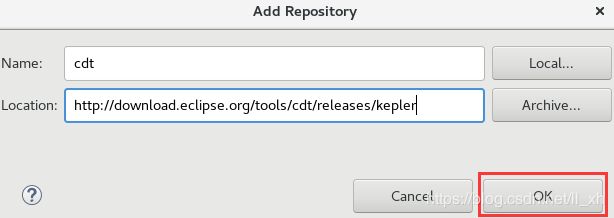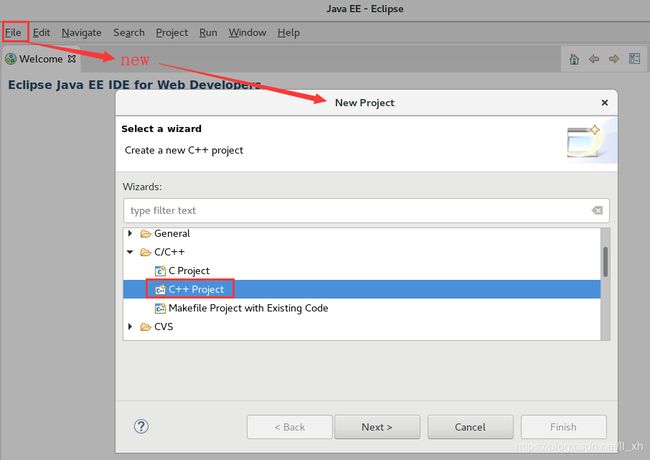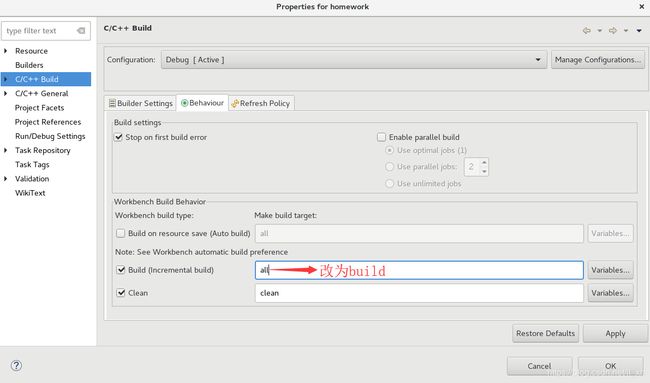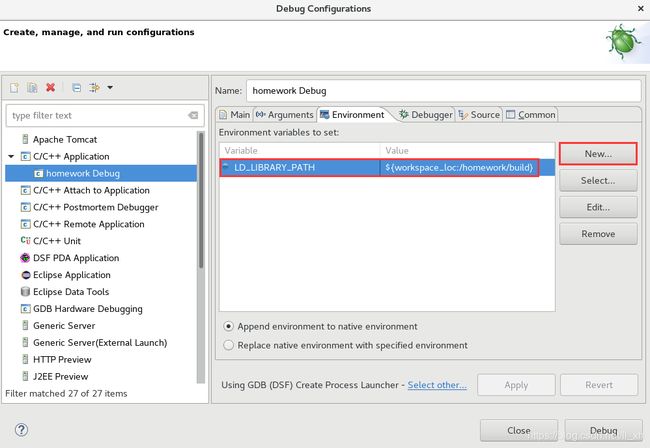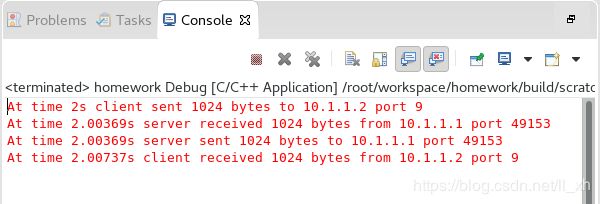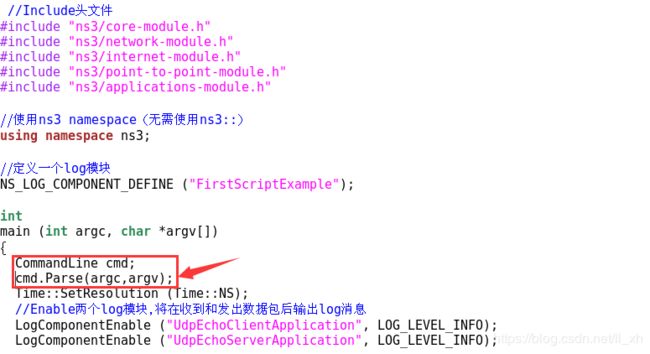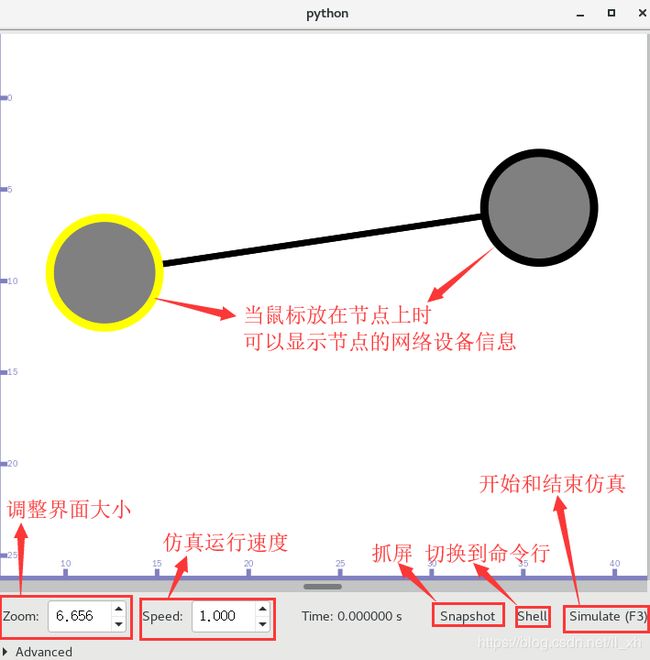Centos7下的NS-3安装与配置总结(超详细!超完整!)
CONTENTS
1 NS-3概述
2 平台安装
2.1 安装ns-3的依赖环境
2.2 Downloading ns-3
3 Eclipse配置
3.1 安装Eclipse
3.2 安装cdt
3.3 配置
4 脚本运行
4.1 终端编译运行
4.2 Eclipse编译运行
5 可视化界面
5.1 PyViz安装
5.2 PyViz使用
6 总结
7 附录
7.1 first.cc
7.2 second.cc
8 参考资料
9 版权声明
1 NS-3概述
官网:https://www.nsnam.org/
ns-3 is a discrete-event network simulator for Internet systems, targeted primarily for research and educational use. ns-3 is free software, licensed under the GNU GPLv2 license, and is publicly available for research, development, and use.ns-3是用于因特网系统的离散事件网络模拟器,主要用于研究和教育用途。ns-3是免费软件,根据GNU GPLv2许可证授权,可公开用于研究,开发和使用。
介绍完NS-3的用途接下来就是安装教程啦~
注意:本实验所有操作通过虚拟机直接进入root用户进行操作,默认所有操作都在root权限下进行。
2 平台安装
2.1 安装ns-3的依赖环境
yum install gcc-c++ python
yum install python-devel
yum install mercurial
yum install doxygen graphviz ImageMagick
yum install python-sphinx dia texlive texlive-latex
yum install openmpi openmpi-devel
yum install tcpdump wireshark
yum install sqlite sqlite-devel
yum install libxml2 libxml2-devel
yum install boost-devel
yum install graphviz graphviz-devel python-setuptools-devel ipython
sudo easy_install pygraphviz
yum install goocanvas pygtk2-devel
Then obtain the RPM for pygoocanvas andpygoocanvas-devel from here: http://li.nux.ro/download/nux/dextop/el6/x86_64/
在上面网址下载pygoocanvas-0.14.1-3.el6.nux.x86_64.rpm和pygoocanvas-devel-0.14.1-3.el6.nux.x86_64.rpm,放入/root/packages文件夹中,用rpm进行安装时要在包前加上文件路径。
rpm -ivh /root/packages/pygoocanvas-0.14.1-3.el6.nux.x86_64.rpm --nodeps --force
rpm -ivh /root/packages/pygoocanvas-devel-0.14.1-3.el6.nux.x86_64.rpm --nodeps --force
yum install git
yum install gsl gsl-devel
yum install gtk2 gtk2-devel
yum install gdb valgrind
2.2 Downloading ns-3
创建文件夹:[root@localhost ~]# mkdir tarballs
进入tarballs:[root@localhost ~]# cd tarballs
联网下载: [root@localhost tarballs]# wget http://www.nsnam.org/releases/ns-allinone-3.21.tar.bz2
解压:[root@localhost tarballs]# tar jxvf ns-allinone-3.21.tar.bz2
进入ns-allinone-3.21:[root@localhost tarballs]# cd ns-allinone-3.21
构建安装:[root@localhost ns-allinone-3.21]# ./build.py
进入ns-3.21:[root@localhost ns-allinone-3.21]# cd ns-3.21
使用waf编译安装,使用test.py测试,运行脚本测试:
[root@localhost ns-3.21]# ./test.py
[root@localhost ns-3.21]# ./waf distclean
[root@localhost ns-3.21]# ./waf --build-profile=debug --enable-examples --enable-tests configure
[root@localhost ns-3.21]# ./waf
[root@localhost ns-3.21]# ./test.py -c core
[root@localhost ns-3.21]# ./waf --hello-simulator
通过以上代码和部分压缩吧可以搭建好ns-3.21的环境,接下来是安装eclipse。
3 Eclipse配置
3.1 安装Eclipse
(1)测试一下是否已安装jdk:# java -version
一般centos7已经安装jdk 8.0,如果没安装,在root用户下,输入命令yum install java
(2)下载eclipse:# wget http://mirrors.neusoft.edu.cn/eclipse/technology/epp/downloads/release/luna/SR2/eclipse-jee-luna-SR2-linux-gtk-x86_64.tar.gz
(3)新建一个eclipse文件夹保存下载压缩包:
# mkdir eclipse
# mv /root/eclipse-jee-luna-SR2-linux-gtk-x86_64.tar.gz /root/eclipse
(4)将eclipse压缩包解压到/opt目录下:
# cd eclipse
# tar -zxvf eclipse-jee-luna-SR2-linux-gtk-x86_64.tar.gz -C/opt
(5)建立软连接(等同于快捷方式):
# ln -s /opt/eclipse/eclipse /usr/bin/eclipse
(6)为 Eclipse 设置桌面启动:
# vim /usr/share/applications/eclipse.desktop
并在文件中添加如下内容:
[Desktop Entry]
Encoding=UTF-8
Name=Eclipse 4.4.1
Comment=Eclipse Luna
Exec=/usr/bin/eclipse
con=/opt/eclipse/icon.xpm
Terminal=false
Version=1.0
Type=Application
Categories=Application;Development;Java;IDE
:wq保存退出(7)Eclipse安装完成,可在应用程序——编程中查看
3.2 安装cdt
(1)打开 eclipse ,点击 help-Install new software
点击Add
Nmae:cdt
Location:http://download.eclipse.org/tools/cdt/releases/kepler
点击ok后,再点击右下方next按照需要选择组件继续向下安装即可。
3.3 配置
(1)新建一个C++Project,我将其name命名为homework,这个项目的路径是:/root/workspace/homework
将/root/tarballs/ns-allinone-3.21/ns-3.21目录下的所有文件,全部复制到homework目录中,在eclipse中刷新构建该项目。
(2)进入ns-3.21目录,执行waf配置:
# cd /root/tarballs/ns-allinone-3.21/ns-3.21
# ./waf --build-profile=debug --enable-examples --enable-tests configure
(3)回到eclipse,右击项目homework,选择properties,点击C/C++ build
Build command栏中改写为:${workspace_loc:/homework/waf}
Build directory栏中改写为:${workspace_loc:/homework/build}
点击上方的behaviour,将all改为build
点击apply,ok完成应用设置。
(4)右击homework项目,选择debug as --> debug configure --> 选择C/C++ application
修改C/C++ Application:build/scratch/scratch-simulator
再选Environment,添加如下信息:
Variable:LD_LIBRARY_PATH
Value:${workspace_loc:/homework/build}
(5)运行scratch文件夹下的scratch-simulator.cc,运行结果如下图所示:
至此,eclips配置成功。
4 脚本运行
4.1 终端编译运行
(1)将编写的脚本(first.cc和second.cc)复制到/root/tarballs/ns-allinone-3.21/ns-3.21/scratch目录下,可以在centos7窗口界面直接复制;然后,进入ns3目录:# cd /root/tarballs/ns-allinone-3.21/ns-3.21
(2)构建(编译):# ./waf
(3)运行脚本
运行first.cc脚本:# ./waf --run scratch/first
运行second.cc脚本:# ./waf --run scratch/second
4.2 Eclipse编译运行
(1)将编写的脚本(first.cc和second.cc)复制到/root/workspace/homework/scratch目录下,刷新构建该工程。
(2)右击homework项目,选择debug as --> debug configure --> 选择C/C++ application
修改C/C++ Application:build/scratch/first
然后点击apply应用于该项目。
(3)打开first.cc文件,运行可的如下结果:
5 可视化界面
PyViz是一个用Python开发的在线ns-3可视化工具,不需要使用trace文件
5.1 PyViz安装
(1)首先需要检查机器上是否有epel仓库,因为会用到里面的一些包。如果有结果则从(2)开始向下进行,如果无显示则表明本机无epel仓库需要继续执行后续操作。
检查epel仓库:# rpm -qa | grep epel
安装epel:# yum -y install epel-release
查看仓库信息:# yum repolist
(2)安装该模块依赖的软件包
# yum install python-devel gnome-python2 gnome-python2-gnomedesktop gnome-python2-rsvg graphviz-python pygoocanvas python-kiwi graphviz-devel
(红色字体的包我没有在yum,epel源中找到,暂时不知是否会对以后操作有影响,所以暂且搁置。做完回来发现这三个包即使没有找到未安装,最后的可视化界面也能出来,还是没有搞懂,我还是自己再研究研究吧。)
# yum install python
# yum install ipython
# yum install mock
# useradd -s /sbin/nologin mockbuild
# yum install cmake glibc-devel glibc-devel
# easy_install pygraphviz
(3)下载pyviz
pyviz下载网址:http://code.nsnam.org/gjc/
# tar -xzvf ns-3-pyviz-d26a12d3ebb8.tar.gz
解压后将文件夹放在/root/tarballs/ns-allinone-3.21/ns-3.21/目录下,再重新编译如下命令:
# ./waf clean
# ./waf --build-profile=debug --enable-examples --enable-tests configure
(4)用如下命令可以测试是否安装成功:
# ./waf --pyrun src/flow-monitor/examples/wifi-olsr-flowmon.py --visualize
若安装成功则会出现下图:
5.2 PyViz使用
(1)修改脚本
首先,到/root/tarballs/ns-allinone-3.21/ns-3.21/scratch找到first.cc和second.cc;
然后,双击打开这两个脚本,看文件中是否有以下两句,如果没有则添加到两文件的指定位置:
CommandLine cmd;
cmd.Parse(argc,argv);(2)运行脚本显示可视化图像
# ./waf --run scratch/first --vis
# ./waf --run scratch/second --vis
6 总结
拖拖拉拉好长时间终于将NS-3的总体框架搭建成功了~希望对大家的学习有所帮助,有问题可以评论,我会尽力帮大家解决哒~
That is all.
7 附录
7.1 first.cc
/* -*- Mode:C++; c-file-style:"gnu"; indent-tabs-mode:nil; -*- */
/*
* This program is free software; you can redistribute it and/or modify
* it under the terms of the GNU General Public License version 2 as
* published by the Free Software Foundation;
*
* This program is distributed in the hope that it will be useful,
* but WITHOUT ANY WARRANTY; without even the implied warranty of
* MERCHANTABILITY or FITNESS FOR A PARTICULAR PURPOSE. See the
* GNU General Public License for more details.
*
* You should have received a copy of the GNU General Public License
* along with this program; if not, write to the Free Software
* Foundation, Inc., 59 Temple Place, Suite 330, Boston, MA 02111-1307 USA
*/
//Include头文件
#include "ns3/core-module.h"
#include "ns3/network-module.h"
#include "ns3/internet-module.h"
#include "ns3/point-to-point-module.h"
#include "ns3/applications-module.h"
//使用ns3 namespace(无需使用ns3::)
using namespace ns3;
//定义一个log模块
NS_LOG_COMPONENT_DEFINE ("FirstScriptExample");
int
main (int argc, char *argv[])
{
CommandLine cmd;
cmd.Parse(argc,argv);
Time::SetResolution (Time::NS);
//Enable两个log模块,将在收到和发出数据包后输出log消息
LogComponentEnable ("UdpEchoClientApplication", LOG_LEVEL_INFO);
LogComponentEnable ("UdpEchoServerApplication", LOG_LEVEL_INFO);
//NodeContainer:便于我们创建、管理和访问Node对象
NodeContainer nodes;
nodes.Create (2);
//帮助我们配置和连接PointToPointNetDevice和PointToPointChannel
//将Device的数据发送速率设为5Mbps
//将Channel的时延设为2ms
PointToPointHelper pointToPoint;
pointToPoint.SetDeviceAttribute ("DataRate", StringValue ("5Mbps"));
pointToPoint.SetChannelAttribute ("Delay", StringValue ("2ms"));
//使用helper的Install方法在每个节点上创建一个pointToPointNetDevice,
//保存在NetDeviceContainer中,并且还创建了一个PointToPointChannel
NetDeviceContainer devices;
devices = pointToPoint.Install (nodes);
//在两个node上安装协议栈(IP、TCP、UDP等)
InternetStackHelper stack;
stack.Install (nodes);
//管理和分配IPv4地址
//在Device上依次绑定IP地址,10.1.1.1开始,直到10.1.1.254,产生网络接口(interface)
Ipv4AddressHelper address;
address.SetBase ("10.1.1.0", "255.255.255.0");
Ipv4InterfaceContainer interfaces = address.Assign (devices);
//UdpEchoServerApplication和UdpEchoClientApplication
//创建一个工作在端口9的echoServer
UdpEchoServerHelper echoServer (9);
//使用Install方法将Application安装在#1的Node上
//Application在第1秒开始运行,在第10秒停止
ApplicationContainer serverApps = echoServer.Install (nodes.Get (1));
serverApps.Start (Seconds (1.0));
serverApps.Stop (Seconds (10.0));
//指定对端的地址和端口、指定最大发包数、发包间隔、大小
UdpEchoClientHelper echoClient (interfaces.GetAddress (1), 9);
echoClient.SetAttribute ("MaxPackets", UintegerValue (1));
echoClient.SetAttribute ("Interval", TimeValue (Seconds (1.0)));
echoClient.SetAttribute ("PacketSize", UintegerValue (1024));
//使用Install方法在节点0创建echoClient
//第2秒开始、第10秒停止
ApplicationContainer clientApps = echoClient.Install (nodes.Get (0));
clientApps.Start (Seconds (2.0));
clientApps.Stop (Seconds (10.0));
//执行仿真
//按照事件的时序,从第0到第10秒执行
//使用Destroy清理,资源回收
Simulator::Run ();
Simulator::Destroy ();
return 0;
}7.2 second.cc
/* -*- Mode:C++; c-file-style:"gnu"; indent-tabs-mode:nil; -*- */
/*
* This program is free software; you can redistribute it and/or modify
* it under the terms of the GNU General Public License version 2 as
* published by the Free Software Foundation;
*
* This program is distributed in the hope that it will be useful,
* but WITHOUT ANY WARRANTY; without even the implied warranty of
* MERCHANTABILITY or FITNESS FOR A PARTICULAR PURPOSE. See the
* GNU General Public License for more details.
*
* You should have received a copy of the GNU General Public License
* along with this program; if not, write to the Free Software
* Foundation, Inc., 59 Temple Place, Suite 330, Boston, MA 02111-1307 USA
*/
#include "ns3/core-module.h"
#include "ns3/network-module.h"
#include "ns3/csma-module.h"
#include "ns3/internet-module.h"
#include "ns3/point-to-point-module.h"
#include "ns3/applications-module.h"
#include "ns3/ipv4-global-routing-helper.h"
// Default Network Topology
//
// 10.1.1.0
// n0 -------------- n1 n2 n3 n4
// point-to-point | | | |
// ================
// LAN 10.1.2.0
using namespace ns3;
NS_LOG_COMPONENT_DEFINE ("SecondScriptExample");
int
main (int argc, char *argv[])
{
bool verbose = true;
uint32_t nCsma = 3;
//命令行参数,允许用户指定脚本运行时的参数
CommandLine cmd;
cmd.AddValue ("nCsma", "Number of \"extra\" CSMA nodes/devices", nCsma);
cmd.AddValue ("verbose", "Tell echo applications to log if true", verbose);
cmd.Parse (argc,argv);
//根据用户命令行参数,启用Logging
if (verbose)
{
LogComponentEnable ("UdpEchoClientApplication", LOG_LEVEL_INFO);
LogComponentEnable ("UdpEchoServerApplication", LOG_LEVEL_INFO);
}
//个数为1或nCsma
nCsma = nCsma == 0 ? 1 : nCsma;
/**************开始定义网络拓扑***************/
//两个p2p节点:n0和n1
NodeContainer p2pNodes;
p2pNodes.Create (2);
//nCsma个CSMA节点
NodeContainer csmaNodes;
csmaNodes.Add (p2pNodes.Get (1));
csmaNodes.Create (nCsma);
//P2P链路属性
PointToPointHelper pointToPoint;
pointToPoint.SetDeviceAttribute ("DataRate", StringValue ("5Mbps"));
pointToPoint.SetChannelAttribute ("Delay", StringValue ("2ms"));
NetDeviceContainer p2pDevices;
p2pDevices = pointToPoint.Install (p2pNodes);
//总线网络属性
CsmaHelper csma;
csma.SetChannelAttribute ("DataRate", StringValue ("100Mbps"));
csma.SetChannelAttribute ("Delay", TimeValue (NanoSeconds (6560)));
NetDeviceContainer csmaDevices;
csmaDevices = csma.Install (csmaNodes);
//安装协议栈
InternetStackHelper stack;
stack.Install (p2pNodes.Get (0));
stack.Install (csmaNodes);
//分配IP地址
Ipv4AddressHelper address;
address.SetBase ("10.1.1.0", "255.255.255.0"); //p2p网段
Ipv4InterfaceContainer p2pInterfaces;
p2pInterfaces = address.Assign (p2pDevices);
address.SetBase ("10.1.2.0", "255.255.255.0"); //总线网段
Ipv4InterfaceContainer csmaInterfaces;
csmaInterfaces = address.Assign (csmaDevices);
/**************网络拓扑定义结束***************/
/**************应用程序开始***************/
UdpEchoServerHelper echoServer (9);
//服务器在最后一个节点上
ApplicationContainer serverApps = echoServer.Install (csmaNodes.Get (nCsma));
serverApps.Start (Seconds (1.0));
serverApps.Stop (Seconds (10.0));
UdpEchoClientHelper echoClient (csmaInterfaces.GetAddress (nCsma), 9);
echoClient.SetAttribute ("MaxPackets", UintegerValue (1));
echoClient.SetAttribute ("Interval", TimeValue (Seconds (1.0)));
echoClient.SetAttribute ("PacketSize", UintegerValue (1024));
//客户端在n0
ApplicationContainer clientApps = echoClient.Install (p2pNodes.Get (0));
clientApps.Start (Seconds (2.0));
clientApps.Stop (Seconds (10.0));
/**************应用程序结束***************/
//根据节点产生的链路通告为每个节点建立路由信息
Ipv4GlobalRoutingHelper::PopulateRoutingTables ();
//开启pcap跟踪,生成以"second"为前缀的文件名
pointToPoint.EnablePcapAll ("second");
csma.EnablePcap ("second", csmaDevices.Get (1), true);
Simulator::Run ();
Simulator::Destroy ();
return 0;
}8 参考资料
ns-3手册:https://www.nsnam.org/wiki/Installation#CentOS
Centos7下安装配置NS3:https://wenku.baidu.com/view/3670a2ba3086bceb19e8b8f67c1cfad6185fe970.html
NS_3--PyViz:https://blog.csdn.net/wuzhiwuweisun/article/details/79790041
9 版权声明
本文为博主原创文章,未经博主允许不得转载!
联系本博主同意后转载,引用参考请务必注明出处。
如有侵权者,本博主保留追究法律责任的权力。



